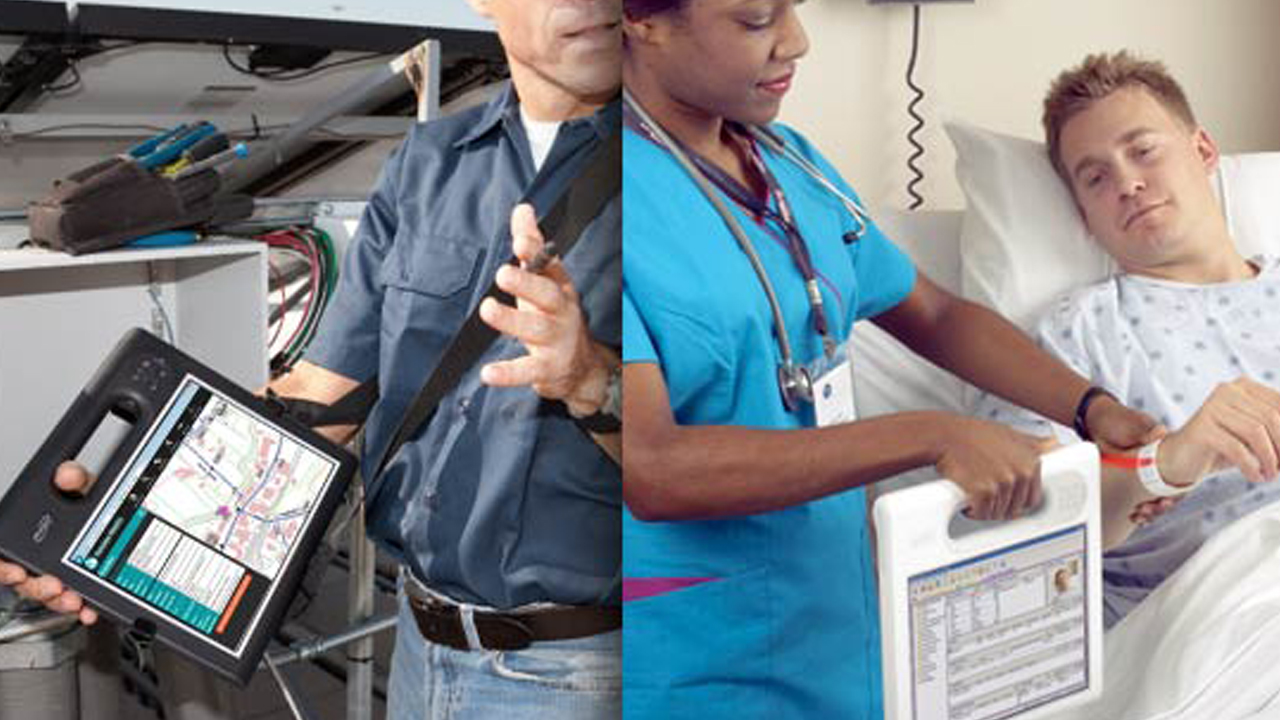
True Story: How Field Service First Got a Handle on Mobility (Thanks to Hospitals)
Bezel-less laptops, smartphones, tablets and TVs are the epitome of beautiful design. They are also the culmination of years of engineering efforts to make electronic devices as lightweight as they can be while offering the largest possible screen.
The pressure to minimize a device’s physical volume, while offering larger screens has been around for decades. And, while consumers love the sleeker devices revealed with every new product generation, there’s a love-hate relationship among engineers and product designers. There is also a lot of peer pressure to “do better” with each design component.
Peer pressure? Among engineers? I used to joke that while we appreciate a good personality among executives and marketers, the “ideal” engineer has no personality. Someone once told me that they thought I had a good personality, and I replied, “I am an engineer. To imply that I have a personality is an insult!” And yet, I can tell you, engineers are heavily influenced by their peers and a drive to deliver the top products on the market. For example, engineers are constantly striving to produce the densest circuit boards or design devices with the thinnest wall thickness among those featuring aluminum or plastic cases. All because customers want lighter devices.
That being said, mobile device design is not always about size. Or, should I say it’s not only about size. At least not for device manufacturers selling to folks who spend all day on their feet: the highly mobile device users. (Think about those in field service, manufacturing, energy, transportation, public safety and government, just to name a few.) For these market segments, many of the product design decisions are focused on improving ease of handling and resisting the “peer pressure” against optimizing ergonomics for only one user type. Thus, the reason why the Zebra XPAD™ L10 rugged tablet literally features a built-in handle.
However, you might be surprised to learn that the XPAD L10 was not the first rugged tablet with a handle. Neither was its generational predecessor, the Zebra F5m (which was acquired along with Xplore Technologies in 2018.) That’s because traditional field-based workers weren’t the only ones struggling to manage a tablet alongside their other “tools” early on in the mobile computing days – or the first to vocalized their frustration with this juggling act. It was nurses and others in healthcare who spent their days on foot.
The origins of “the tablet with the top handle”
About 12 years ago, Intel® Corporation started approaching a number of computer manufacturers with an idea for a Mobile Clinical Assistant (MCA) – a completely mobile solution that would basically replace the traditional clipboard-based patient charts. The idea was to create a more streamlined and secure records management system that would improve provider productivity by allowing access to “important patient information including digital images and patient history details” both at the point of care and in the back-office for billing and other applications. Intel had already developed the software; they just needed someone to engineer a mobile PC platform to deliver it. Rugged tablet OEM Motion Computing* immediately recognized the value of this first-of-its-kind technology concept. It was the perfect opportunity to address an underserved healthcare IT market. The Motion team immediately got to work with Intel to bring the concept to life. Within a matter of months, these Solution Architects engineered the original Mobile Clinical Assistant – which eventually evolved into the Xplore – and now Zebra – C5 rugged tablet.
(Fun fact: The “C” in the Zebra C5 MCA name represents “clinical” and the “5” represents “the 5 rights of the patient for med administration.”)
What’s even more noteworthy is the team’s attention to detail and emphasis on quality during the development and testing stages. It was a first-generation product. Really, the first of its kind in the market. Some engineers may have been willing to compromise on certain features or capabilities just to be the fastest to market. The C5 design team was more focused on getting the tablet solution right the first time. In fact, they spent months consulting with potential end-users – clinicians, nurses, even a healthcare advisory board convened specifically for this project – to understand not just the workflows, but the nuances of their day-to-day movements. They knew that they needed to build in a barcode scanner to allow for fast capture of patient wristband data and a camera to aid with visual documentation for electronic medical records (EMR/EHR). They also knew that an integrated top handle would improve tablet management while bedside better than a case and strap accessory. The attached handle would also allow the tablet to be securely carried in hand or hung on a hook outside patient rooms for shared access. On top of all that, the tablet needed to be rugged enough to survive amidst what they expected to be frequent drops and exposure to fluids and other contaminants. It also needed to be easy to sanitize, which at the time meant that it needed to be white (which was considered ideal for sanitation purposes). Of course, it also needed a secure mounting option for when users needed to put it down on the cart, or even an office desk, for more data intensive tasks or file transfers.
Fortunately for Intel, the healthcare industry and – we’d soon learn – every field-based worker in every industry: The engineering team brilliantly delivered the C5 mobile and mountable solution, and they set a new standard in rugged tablet design that has yet to be matched in the last decade. They figured out how to work these mandatory features into what would become a not-so-traditional tablet design without comprising other requirements such as reliable connectivity, data input tools (i.e. pen touch) and the usual central processing unit (CPU) and drive considerations. They even determined that if users braced the already lightweight tablet at their hip versus carrying it down by their side with arms extended that it would become even lighter and easier to hold for longer periods of time.
Now, these may seem like tiny considerations, but they certainly went a long way in establishing a precedent in mobile computing. In fact, it wasn’t long after the C5 started garnering nationwide media attention and widespread healthcare industry adoption that Motion started fielding requests from those in the construction industry. Builders and architects found the top-handle rugged tablet platform perfect for their work environment. There was one catch, though. The white tablet wasn’t going to cut it at construction sites where dirt, dust and other debris are par for the course. So, the rugged tablet engineers went back to work to make a few design changes to the C5 to accommodate these customer requests. And, that’s how the black “dirt friendly” F5m model (now the Zebra XPAD L10) was born.
It was because of one customer request 10 years ago (and an engineering team willing to accommodate such custom requests) that tens of thousands of utility, construction, retail, energy, manufacturing and even government users gained the one mobile technology tool that – to this day – consistently enables them to excel at their jobs. In fact, the F5m tablet lineup was so successful, that Xplore – and now Zebra – have continued to innovate around this specific tablet design. The fast, ongoing adoption of “the rugged tablet with the handle” has led engineers to integrate much faster processers and state-of-the-art radios, achieve stingier power use, add a bridge battery function, and much more over the years. They’ve succeeded every time. So much so that the latest Zebra XPAD L10 model still retains many of the same design cues – and roughly the same form factor – as the original Motion F5. That means that the workflows and use cases for that design from over a decade ago can still be used today!
And, though the flagship “rugged tablet with a top handle” may have gone through many iterations of its internal components over the years, the C5, F5 and (optionally) now XPAD L10 have always featured an internal barcode scanner with the imager window at the right side of the handle and activation buttons right where your thumb falls. They have always boasted the optimal antenna placement as well. After all, it is that functional, customer-defined engineering that has enabled this unique rugged tablet form factor to retain its appeal.
Indeed, the XPAD L10 rugged tablet platform demonstrates Zebra’s focus on serving customer needs. Some even argue that no single rugged tablet has better served such a wide market segment in history than this platform. Whether you agree or not, there’s no arguing against the fact that the XPAD L10 – along with its F5 predecessor – is a magnificent engineering feat in the world of mobile computing.
###
*Editor’ Note: Xplore acquired Motion Computing assets in April 2015. Zebra then acquired Xplore and its assets in October 2018.

Bob Ashenbrenner
Durable Mobility Technologies, LLC, under the direction of Bob Ashenbrenner, works with Zebra Technologies to develop future-proof mobility solutions for customers across multiple field service and industrial sectors. As an industry consultant, Durable Mobility Technologies, LLC, is focused on optimizing rugged tablet-based solutions for mobile workers of all kinds, including utility and public safety professionals. Ashenbrenner is particularly committed to helping customers identify mobile devices that survive a tough work day, run all the software and tools needed today, and will remain flexible and scalable to adapt to evolving technology applications as business needs dictate.
Ashenbrenner has more than 25 years of computer engineering and engineering management experience, with 18 of those specific to mobility and the field requirements that enable real work to happen. He was previously a Solutions Architect with Xplore Technologies and Motion Computing for 13 years. In that role, Ashenbrenner led the development of a suite of rugged mobile tablet computer, services and software, with an emphasis on supporting the whole mobile work environment.




